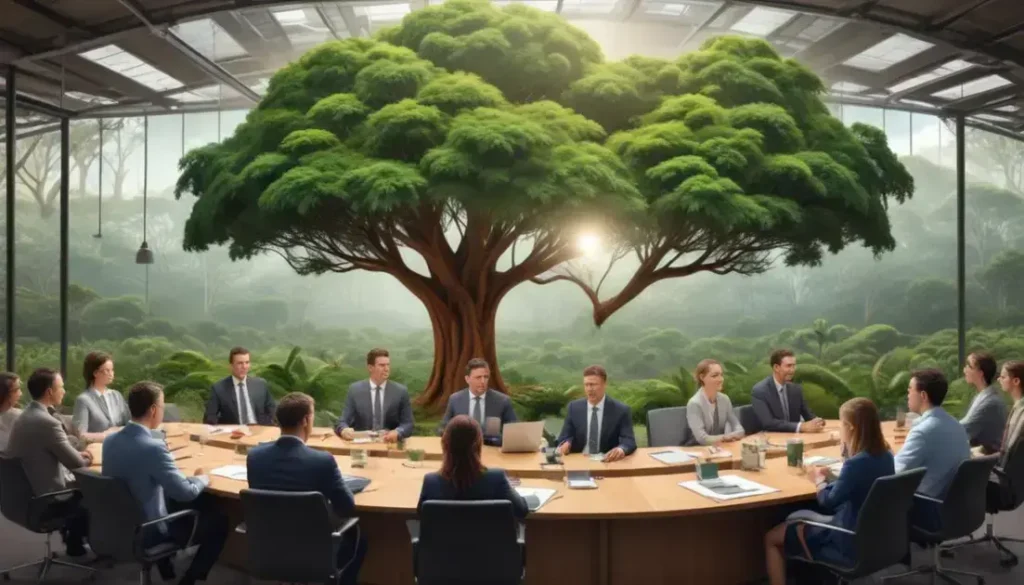A circular economy focuses on reusing materials and minimising waste to create a sustainable system that benefits businesses, consumers, and the environment by promoting recycling, innovation, and resource efficiency.
In today’s market, circularity is more than just a buzzword; it represents a vital shift in how we think about sustainability. Have you considered how your business could leverage this trend?
Understanding Circularity and Its Importance
Understanding circularity is crucial for businesses seeking to thrive in an ever-evolving market. This concept revolves around creating closed-loop systems where resources are reused, remanufactured, and recycled. By adopting circularity, companies can minimise waste and reduce their environmental footprint while also benefiting economically.
One of the main advantages of implementing circular practices is the potential for cost savings. Businesses can significantly lower materials costs by reusing and recycling existing resources rather than continually sourcing new materials. This also creates opportunities for innovation, as companies are challenged to develop new products that align with circular principles.
The demand for sustainability is growing among consumers, making it essential for businesses to adopt circularity not just for compliance purposes, but to enhance their brand image. Companies that successfully integrate circular practices often see increased customer loyalty and can differentiate themselves in competitive markets. It’s not merely a trend, but a transformative approach that aligns with contemporary consumer expectations.
Moreover, as regulations become stricter, understanding and embracing circularity will be crucial to remain compliant. Engaging with stakeholders and developing circular supply chains will foster collaboration and drive industry-wide change. This cooperative approach can unlock new profitable avenues for businesses, ensuring their longevity and relevance in the future.
The Impact of Tariffs on Global Supply Chains
The impact of tariffs on global supply chains is profound, influencing how businesses operate and strategise in the international market. Tariffs can increase costs for companies that rely on imported goods, forcing them to reassess their sourcing strategies. In many cases, businesses may seek alternative suppliers or relocate production to mitigate these additional costs.
Furthermore, tariffs can lead to disruptions in established supply chains. These disruptions may cause delays and affect inventory management, as companies struggle to adapt to new trade regulations. As a result, businesses must invest in supply chain resilience and agility to navigate the shifting landscape effectively.
Another consideration is the ripple effect tariffs have on consumer prices. Increased tariffs can result in higher costs for end products, placing a burden on consumers and potentially reducing demand. Companies must balance these cost increases with the need to remain competitive in a dynamic market.
Adopting innovative approaches, such as developing local supply networks or leveraging technology for smarter logistics, can help businesses adapt to the challenges presented by tariffs. Understanding the broader implications of tariff policies is essential for businesses aiming to maintain competitive advantage and foster sustainable growth in a rapidly changing global environment.
Consumer Preferences for Sustainable Products
Consumer preferences for sustainable products have shifted dramatically in recent years. Today’s customers are increasingly aware of their environmental footprint and are actively seeking products that reflect their values. This trend is not just a passing fad; it signals a fundamental change in purchasing behaviour influenced by a desire for ethical consumption.
Research indicates that many consumers are willing to pay a premium for sustainable options. This willingness opens up new opportunities for businesses that align their offerings with eco-friendly practices. Brands that demonstrate transparency and commitment to sustainability often build stronger relationships with their customers.
One of the driving factors behind this shift is the increasing accessibility of information. Social media and online platforms enable consumers to research products, making it easier to identify brands that prioritise sustainability. Companies must thus engage effectively through these channels to communicate their sustainability efforts clearly.
Additionally, younger generations, particularly millennials and Gen Z, are taking the lead in driving demand for sustainable products. Their preferences are reshaping entire industries, pushing brands to innovate and adapt to meet these changing expectations. As businesses respond to this trend, they not only enhance their reputation but also contribute positively to global sustainability efforts.
How Australian Businesses Can Adapt to Circular Practices
Australian businesses can successfully adapt to circular practices by embracing innovative strategies and sustainable processes. Understanding the principles of circularity is essential; it involves redesigning products and services to minimise waste and make the most of available resources. This shift not only helps the environment but can also drive cost savings and enhance brand reputation.
First, businesses should conduct a thorough assessment of their current operations. This includes identifying areas where waste can be reduced, materials can be recycled, and products can be reused. By mapping out these opportunities, companies can create strategies tailored to their specific needs and capabilities.
Engaging with stakeholders is another key step. Collaborating with suppliers, customers, and industry peers can foster innovation and provide insights into best practices. Sharing resources and knowledge accelerates the transition toward circularity, as businesses can learn from one another’s experiences.
Additionally, investing in technology plays a crucial role in this transformation. Implementing tools that facilitate tracking, data analysis, and recycling processes can optimise efficiency. As more companies transition to circular practices, they will not only meet consumer demands for sustainability but also contribute to broader environmental goals, paving the way for a more resilient future.
The Role of AI and Robotics in Circular Economy
The role of AI and robotics in the circular economy is increasingly vital as businesses seek more sustainable operations. These technologies enhance efficiency, optimise resource use, and streamline waste management processes. AI-powered systems enable companies to analyse large datasets to identify patterns and improve recycling processes, thereby reducing waste and enhancing the lifecycle of products.
Robotics, on the other hand, plays a crucial role in automating repetitive tasks associated with sorting and processing materials. Automated systems can significantly increase productivity as they perform tasks consistently and accurately, reducing human error. This not only helps in the efficient recovery of materials but also reduces operational costs associated with manual labour.
Integrating AI with robotics creates intelligent systems that can adapt to changing conditions in real-time. For instance, they can modify sorting processes based on the type and quality of materials available. This flexibility is crucial for enhancing recycling rates and ensuring that valuable resources are not lost.
Moreover, AI can aid in product design by simulating various scenarios to identify the most sustainable approaches. This ability to predict outcomes makes it easier for businesses to adopt circular principles early in the design stage, fostering a culture of sustainability throughout the product lifecycle.
Benefits of Reusing Materials in Local Supply Chains
The benefits of reusing materials in local supply chains are significant and multifaceted. By reintroducing used materials into the production process, businesses can significantly reduce their overall waste. This not only helps the environment but also contributes to a more sustainable model of operation that local communities can support.
One of the primary advantages is the cost savings associated with reduced raw material purchases. Businesses that reuse materials often find themselves less dependent on volatile global markets for new resources. This stability allows for better financial forecasting and can bolster a company’s bottom line.
Reusing materials also fosters local economic development. When companies source reused materials locally, they contribute to a circular economy, keeping money within the community and supporting local jobs. This practice encourages partnerships among businesses, creating a collaborative approach to sustainability.
Moreover, reusing materials enhances a company’s brand image. Consumers are increasingly drawn to businesses that demonstrate commitment to sustainability. By showcasing efforts to recycle and reuse, companies can attract environmentally conscious customers, enhancing loyalty and market share.
Lastly, the practice of reusing materials can lead to innovation. Companies often discover new ways to incorporate waste into their products, sparking creativity and differentiation in a competitive market.
Case Studies: Successful Circular Models
Examining case studies of successful circular models provides valuable insights into how businesses can effectively implement sustainability practices. Companies like Interface, a carpet tile manufacturer, have pioneered sustainable production methods by using recycled materials and adopting a take-back programme. This initiative allows customers to return old carpets for recycling, significantly reducing waste and environmental impact.
Another notable example is Patagonia, an outdoor clothing brand that advocates for environmental responsibility. By offering repair services and promoting the resale of used items, Patagonia not only extends the life of its products but also encourages customers to embrace a culture of reuse. This approach enhances brand loyalty and positions Patagonia as a leader in sustainable fashion.
A similar model can be seen with philips. They have shifted from selling products to offering services that support product life cycles. Their “Pay-per-Lux” model allows companies to pay for lighting as a service, incentivising Philips to design products that are long-lasting and easily maintainable.
These successful case studies demonstrate the potential benefits of circular models. They not only highlight innovative approaches to reducing waste but also showcase how sustainability can drive profitability and customer engagement, paving the way for other businesses to follow suit.
Challenges in Implementing Circularity
Implementing circularity in business models presents several challenges that companies must navigate to achieve sustainable practices. One of the primary obstacles is the initial cost investment. Transitioning to a circular model often requires significant capital for new technologies, infrastructure, and training. While these investments may pay off in the long term, the upfront costs can be a barrier for many organisations.
Another challenge is the complexity of supply chains. Circular practices necessitate redesigning existing processes, which can disrupt established supplier relationships and logistics. Companies may struggle to find suppliers that share their commitment to circularity, making collaboration essential yet difficult.
Moreover, consumer awareness and behaviour play a crucial role. Even with sustainable products, companies can face challenges in convincing consumers to choose circular options over cheaper or convenience-based alternatives. Education and engagement initiatives are vital to change consumer mindsets towards sustainability.
Finally, there is often a lack of regulatory support. Many regulations still favour linear production models, which can hinder the growth of circular initiatives. Advocating for supportive policies and engaging with regulators is necessary to create an environment that fosters circular economy principles.
Future Trends: The Growing Demand for Circular Solutions
Future trends indicate a significant shift towards the growing demand for circular solutions across various industries. As consumers become increasingly aware of their environmental impact, they are actively seeking products that reflect sustainable practices. This shift is pushing businesses to adopt circular economy principles to meet changing consumer expectations.
The rise of regulatory frameworks supporting sustainability is another driving factor. Governments worldwide are implementing policies that encourage waste reduction and resource efficiency, compelling businesses to rethink their production processes. Compliance with these regulations can enhance a company’s competitive edge in the market.
Technological advancements also play a crucial role in fostering circular solutions. Innovations in materials science, such as biodegradable plastics and sustainable materials, enable companies to develop products that align with circular principles. Furthermore, automation and AI are streamlining recycling processes, making it easier to reclaim and repurpose materials.
Collaboration is becoming essential as industries seek to implement circular strategies effectively. Partnerships between businesses, governments, and NGOs can drive innovation and create new opportunities for resource sharing. Such collaborations foster a community approach to sustainability, where knowledge and resources are exchanged to enhance the overall circular economy.
Embracing Circularity for a Sustainable Future
The shift towards a circular economy represents a significant opportunity for businesses to enhance sustainability while driving innovation. By rethinking how we produce, consume, and dispose of materials, companies can reduce waste and improve their environmental footprint.
Businesses that adopt circular practices not only meet the growing demand for sustainable products but also position themselves as leaders in their industries. Education, collaboration, and investment in new technologies will be key to overcoming the challenges associated with this transition.
As more organisations share successful case studies and best practices, the movement towards circular solutions will gain momentum. This collaborative approach will foster a healthier planet and ensure sustainable business growth.
In conclusion, embracing circularity is not just an option; it is a responsibility that paves the way for a brighter, more sustainable future for all.
Frequently Asked Questions
What is a circular economy?
A circular economy is a model that aims to eliminate waste by keeping resources in use for as long as possible. It focuses on reusing, recycling, and repurposing materials to create a sustainable system.
How can businesses benefit from adopting circular practices?
Businesses can benefit by reducing costs associated with raw materials, improving their brand image, and meeting consumer demand for sustainable products, which can lead to increased customer loyalty.
What are some examples of successful circular models?
Successful circular models include companies like Patagonia, which promotes product repairs and resale, and Interface, which recycles old carpet tiles to create new products.
What challenges do businesses face when implementing circularity?
Challenges include high initial costs, complexities in supply chains, consumer awareness, and regulatory barriers that may favour traditional linear models.
How can technology facilitate circular solutions?
Technology can improve recycling processes, enhance product design for longevity, and enable efficient tracking of materials, thereby helping businesses adopt circular practices more effectively.
What role do consumers play in the transition to a circular economy?
Consumers play a crucial role by demanding sustainable products and supporting businesses that prioritise circular practices, driving the market towards more sustainable options.


